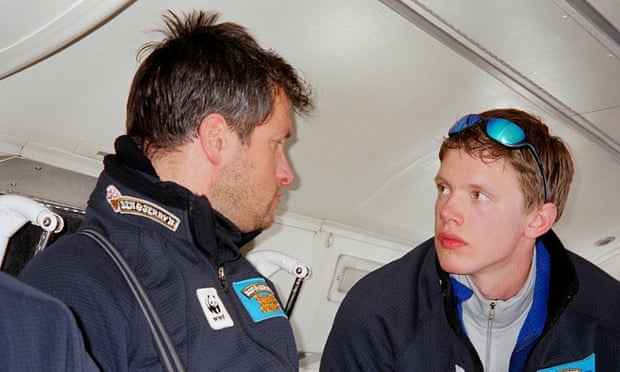At the end of April these two scientists were skiing in their underwear because of the head and became victims of the thin ice they were researching.
These
2 heroic scientists died while studying the climate
8
May, 2015
Early
last month, veteran polar explorers and scientists Marc Cornelissen
and Philip de Roo set out on skis from Resolute Bay, a remote outpost
in the patchwork of islands between Canada and Greenland. Their
destination was Bathurst Island, a treacherous 70-mile trek to the
northwest across the frozen sea, where they planned to document
thinning Arctic sea ice just a few months after NASA reported that
the winter ice cover was the lowest
on record.
It
wasn’t hard to find what they were looking for, according to
a dispatch Cornelissen
uploaded to Soundcloud on April 28.
“We’re
nearing into the coast of Bathurst,” he said. “We think we see
thin ice in front of us … Within 15 minutes of skiing, it became
really warm. In the end, it was me skiing in my underwear … I don’t
think it looked very nice, and it didn’t feel sexy either, but it
was the only way to deal with the heat.
His
next message, a day later, was an emergency distress signal picked up
by the Royal Canadian Mounted Police. According
to the Guardian,
a pilot flying over the spot reported seeing open water, scattered
equipment, and a lone sled dog sitting on the broken ice. By last
Friday, rescuers had called off the search. The pair are presumed to
have drowned, victims of the same thin ice they had come to study.
Cornelissen was 46; de Roo had just turned 30.
Wednesday, Cold
Facts,
the nonprofit with whom the pair was working at the time, dispatched
a snowmobile expedition to attempt to recover their belongings. You
can follow their progress on Twitter here.
The dog, Kimnik, was found a few days ago and is doing fine, the
group said.
In
a blog
post on
the website of the European Space Agency, Cornelissen was remembered
by former colleagues as “an inspirational character, an explorer
and a romantic. He had fallen in love with the spellbinding beauty of
the poles and had made it a personal mission to highlight the
magnitude of the human fingerprint on this last wilderness.”
It’s
not clear whether the ice conditions the pair encountered were
directly attributable to climate change, according to E&E
News:
“We’re nearing into the coast of Bathurst,” he said. “We think we see thin ice in front of us … Within 15 minutes of skiing, it became really warm. In the end, it was me skiing in my underwear … I don’t think it looked very nice, and it didn’t feel sexy either, but it was the only way to deal with the heat.
His next message, a day later, was an emergency distress signal picked up by the Royal Canadian Mounted Police. According to the Guardian, a pilot flying over the spot reported seeing open water, scattered equipment, and a lone sled dog sitting on the broken ice. By last Friday, rescuers had called off the search. The pair are presumed to have drowned, victims of the same thin ice they had come to study. Cornelissen was 46; de Roo had just turned 30.
Wednesday, Cold Facts, the nonprofit with whom the pair was working at the time, dispatched a snowmobile expedition to attempt to recover their belongings. You can follow their progress on Twitter here. The dog, Kimnik, was found a few days ago and is doing fine, the group said.
In a blog post on the website of the European Space Agency, Cornelissen was remembered by former colleagues as “an inspirational character, an explorer and a romantic. He had fallen in love with the spellbinding beauty of the poles and had made it a personal mission to highlight the magnitude of the human fingerprint on this last wilderness.”
It’s not clear whether the ice conditions the pair encountered were directly attributable to climate change, according to E&E News:
That the region had thin ice is evident. Perhaps the ice had been thinned by ocean currents that deliver warm water from below, or by the wind, which could generate open water areas. It is difficult to know. Climate change may have played a role, or it may not have … the impacts of the warming on ice thickness regionally can be unpredictable, [ESA scientist Mark] Drinkwater said.
Still, the Arctic is warming twice as fast as anywhere else on Earth. We rely on the work of scientists like these to know exactly what is happening there and how it will affect those of us who choose to stay safe in warmer, drier places. Their deaths are a testament to the dedication and fearlessness required to stand on the front lines of climate change.
Rest in peace, guys.
y ocean currents that deliver warm water from below, or by the wind, which could generate open water areas. It is difficult to know. Climate change may have played a role, or it may not have … the impacts of the warming on ice thickness regionally can be unpredictable, [ESA scientist Mark] Drinkwater said.
Still,
the Arctic is warming twice as fast as anywhere else on Earth. We
rely on the work of scientists like these to know exactly what is
happening there and how it will affect those of us who choose to stay
safe in warmer, drier places. Their deaths are a testament to the
dedication and fearlessness required to stand on the front lines of
climate change.
Rest
in peace, guys.
This tribute appeared in yesterday's Guardian

Arctic
activists Marc Cornelissen and Philip de Roo’s last expedition
ended tragically in April when they fell through thinning ice. Fellow
environmental campaigner Ruth Dawkins recalls the vital work and warm
spirits of her inspirational friends




No comments:
Post a Comment
Note: only a member of this blog may post a comment.